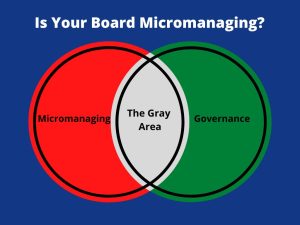Find Out: Is Your Nonprofit Board Micromanaging? Or not?
The Board Micromanaging Quiz
Suggested Answers
Board Meetings
| 1. A board member asks about a staff member’s responsibilities. | No |
| 2. When the CEO steps out of the room, the Board assigns a staff member in the room to complete a task. |
Yes[1] |
| 3. The Board asks the CEO if staff can take on a committee assignment. | No |
| 4. The Board tells the CEO how to fix an operation snafu. | Yes |
| 5. The Board creates a policy to correct an operation snafu. | No |
Committee Meetings
| 6. A member voices an opinion about the CEO’s decision on an operations issue and asks for a report at the next board meeting.
|
Yes[2] |
| 7. A member assigns a staff member to complete a committee task. | Yes |
| 8. A member discovers an accounting process error and informs the CFO how to correct it.
|
Yes |
| 9. A member discovers an accounting process error, informs the CFO how to correct it, and emails the board chair and CEO afterward to explain what happened.
|
Yes[3] |
| 10. Three board members decide they would like to discuss an HR policy at the next board meeting and ask the CEO to put it on the agenda. | No |
Individual Encounters
| 11. The Chair shares ideas on an internal challenge without asking if input would be helpful.
|
Yes |
| 12. After confirming that the input is welcome, the Chair provides ideas on an internal challenge.
|
No |
| 13. At a networking event, a board member asks a staff member to send program information to a new contact. |
No[4] |
| 14. At a networking event, a board member grills a staff member on why the nonprofit runs a program the way it does. He frowns at the answers.
|
Yes |
| 15. The Board Chair passes on three employee supervision recommendations developed during the CEO’s evaluation. | No |
No matter your score now, talking about places where the board, staff, or you are confused will help you to reduce both micromanaging and the gray area and move your board to more governance.
Read How Can You Stop Your Board from Micromanaging? for more information about board micromanaging. Need more help with your board? Karen is available for a mini-consult or more. Click here to email or here to set a time to chat.
[1] Better: the board asks the CEO to assign the task.
[2] Better: If the Committee agrees, they bring this request to the board, which asks the CEO to create the report.
[3] Practical: Sometimes micromanaging makes sense, for instance, if the issue is time sensitive. Solving the challenge and keeping communications open invites discussing handling and avoiding similar situations.
[4] Assuming this is information that staff would share with the public.
Categories
If you appreciate these Added Value posts, please consider subscribing.
Latest Posts
- How New Nonprofit CEOs Secure Board Buy-In for Strategic Planning
- How Nonprofit Leader Navigate Crisis with Clarity & Confidence
- One Way AI Can Help You Find a Path Where None Exists
- In Crisis? Resist Cutting Your Ability to Make Income
- Nonprofit Strategic Planning Assessment: 10 Questions to Strengthen Your Strategy

